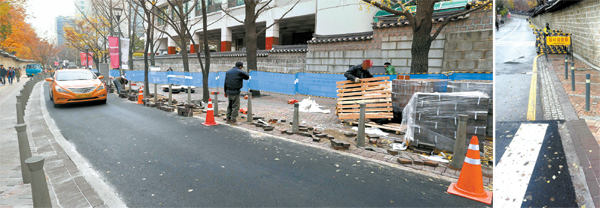Asphalt mars palace walkway’s scenic charm

The sidewalk near Deoksu Palace, known as one of the best walking courses in Seoul, is being narrowed as part of an initiative to widen the paved road for tourist buses carrying an increasing number of visitors. By Byun Sun-goo
But many vehicles that have passed through recently have been going at least 10 to 20 kilometers faster.
For the most part this began after the district office starting expanding the driveway at the expense of the pedestrian walkway, which was noticeably trimmed down.
And many have voiced concerns that this picturesque road, flanked by a stone wall, has lost much of its charm since the Jung District Office paved over part of the walking path.
Initially covered with stones, the road added to the traditional, tranquil atmosphere of the tourist site, with the ancient palace at its heart.
The district office said that the transformed road is for the convenience of drivers and tourist buses, but critics argue that the move has only served to harm one of the few lovely streetscapes in Seoul.
One of the more popular destinations in Seoul, the 900-meter roadway near the palace was designated as a special district in 1998, when the pedestrian road took up a larger area than the drive to better accommodate visitors and tourists.
The walkway was built using eco-friendly materials and included more than 20 benches and 130 trees along the stretch.
The Seoul city government initially spent 700 million won ($660,100) to expand the pedestrian path to 8 meters, while reducing the width of the driveway to 7 meters.
But now, the Seoul Metropolitan Government has reversed its position, allocating 100 million won for the expansion of the driveway by 20 to 50 centimeters. The district office argued that the shift was necessary to accommodate large tour buses.
“More and more tour buses have come to the area as the number of tourists has increased,” said Hwang Tae-kyung, an official of the Jung District.
“There have been a lot of complaints claiming that the buses harm the street stones of the pedestrian road because the width of the driveway is too narrow,” he added. “A total of 101 complaints were reported between April and September.”
However, those opposed to the shift say that the move will degrade the symbolic meaning of the popular roadway.
“Most of Korea’s roads tend to be more considerate of cars rather than walkers,” said Kim Seong-gyun, a landscape architecture professor at Seoul National University, who also had a hand in designing the pedestrian walkway in 1998. “The design of the Deoksu Palace road was considered a significant move to make the roadway more pedestrian friendly. But as the Seoul city government changes that initiative, such a campaign can’t get momentum.”
A resident of the area also expressed discontent.
“I’ve lived here for 13 years,” said Lee Eul-young, 68. “I have often strolled along the road. But now there are lots and lots of cars, and if the city paves the road with asphalt, more and more cars will enter, making it hard for walkers to walk along and take in the view.”
BY MIN KYUNG-WON [ejpark@joongang.co.kr]










with the Korea JoongAng Daily
To write comments, please log in to one of the accounts.
Standards Board Policy (0/250자)